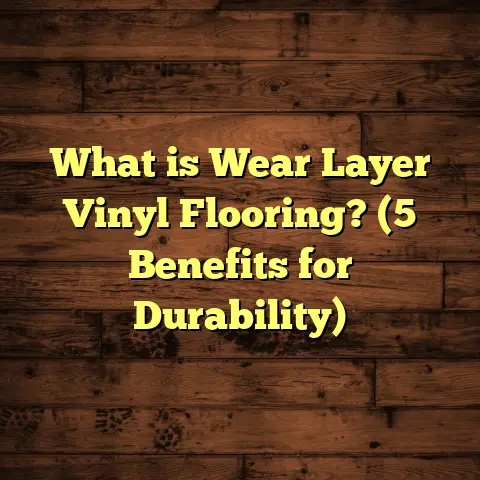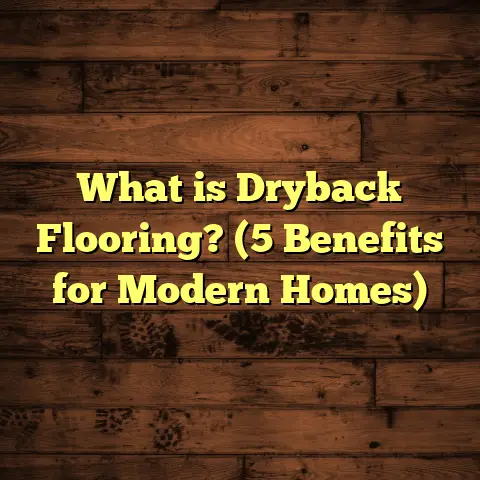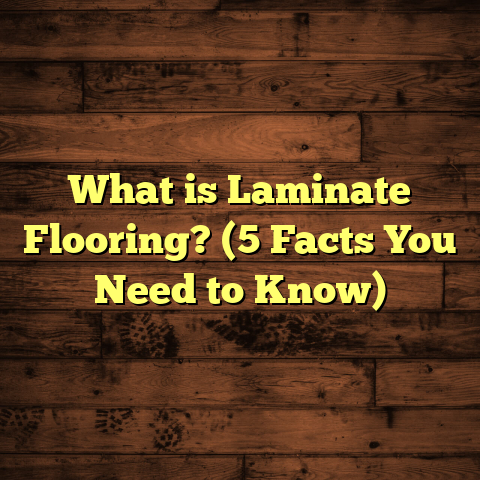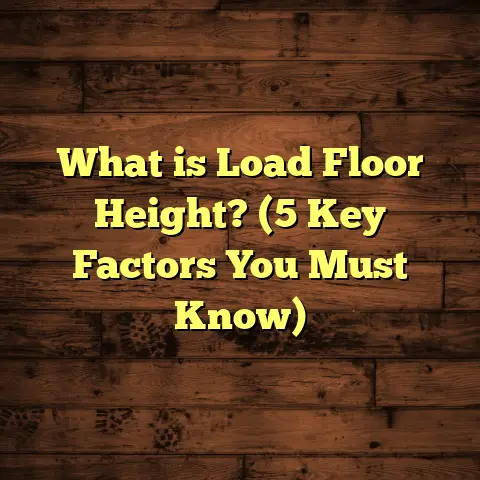What is Alterna Flooring Made of? (5 Key Materials Explained)
A strange thing about flooring is that it’s all around us, yet very few people actually stop to think about what goes into their floors. When I first started as a flooring contractor, I was surprised by how many clients had no idea what materials made up the products they were buying. This was especially true with newer engineered products like Alterna flooring, which promises the look of real wood or stone but with added durability and moisture resistance.
So, what exactly is Alterna flooring made of? Why does it perform so well in kitchens, basements, and other challenging spaces? And how does it compare to solid hardwood or laminate floors? I’ve been working hands-on with this product for years now. I’ve installed it in homes, offices, and commercial spaces. Along the way, I gathered data, insights, and personal stories that I want to share with you.
Let’s walk through the five key materials that compose Alterna flooring and why each one matters. I’ll also talk about maintenance, cost estimation (including how I use FloorTally to keep my quotes accurate), and finally, a comparison with other popular flooring options.
What Is Alterna Flooring?
Alterna flooring is a type of engineered floor product that combines several materials designed to mimic the look of natural hardwood or stone but with enhanced durability and moisture resistance. Unlike traditional solid hardwood floors, which are made from a single piece of wood, Alterna flooring layers different materials to create a stronger, more flexible plank.
It’s part of a broader category often called luxury vinyl plank (LVP) or engineered vinyl flooring but with distinct construction features that set it apart.
How Does Alterna Fit Into the Flooring Market?
When I first encountered Alterna flooring about eight years ago, it struck me as a hybrid product. It’s engineered to bring together the best of several worlds:
- The visual appeal of hardwood or stone thanks to high-definition printed designs.
- The durability and water resistance of vinyl.
- The structural stability gained from composite core materials.
- The ease of installation with click-lock systems.
Alterna has found favor in places where traditional hardwood floors struggle—think busy kitchens where spills happen daily or basements where moisture is a constant challenge.
The 5 Key Materials in Alterna Flooring
To really appreciate what Alterna flooring is made of, you have to understand the role each material plays in its construction. Here’s a detailed look at the five main components:
1. High-Density Fiberboard (HDF) Core
At the heart of many Alterna floors lies a core made from High-Density Fiberboard (HDF). HDF is essentially wood fibers that have been compressed under intense heat and pressure to form a dense sheet.
Why HDF?
I’ve installed plenty of floors with plywood or MDF cores before, and HDF stands out because of its density and stability.
- Durability: HDF is denser than regular MDF or particleboard. For context, typical HDF density ranges between 800–900 kg/m³ compared to MDF at around 600–700 kg/m³. This higher density makes the core resistant to dents and impacts.
- Moisture Resistance: While not waterproof on its own, HDF swells less than plywood when exposed to humidity. This helps prevent warping and buckling.
- Cost: It strikes a balance between cost-efficiency and performance. Naturally, solid wood cores are pricier but don’t offer the same resistance to environmental changes.
Real-world example:
I remember working on a project where moisture was a huge concern—a commercial kitchen with frequent steam and spills. The HDF core in the Alterna planks helped maintain flatness and prevented swelling better than some plywood-based laminate floors I’ve worked with.
How HDF is made:
The process involves breaking down wood chips into fibers using steam and mechanical action, then pressing them into boards with resins added for strength. This method creates a homogenous sheet that’s ideal for flooring cores.
2. Vinyl Wear Layer
One of the most critical layers in Alterna flooring is the vinyl wear layer on top. This transparent film acts as a protective shield.
What does it do?
- Scratch Resistance: The vinyl wear layer contains additives like aluminum oxide that provide abrasion resistance. This means it can handle pets’ claws, furniture movement, and everyday foot traffic without showing wear.
- Stain Resistance: The layer is sealed tightly against liquids, preventing stains from soaking into the decorative printed layer below.
- UV Protection: Sunlight can cause fading over time. The wear layer includes UV inhibitors to keep colors vibrant longer.
Thickness matters:
In my experience, floors with wear layers thinner than 0.3mm tend to show scratches quickly. Alterna floors usually have wear layers between 0.3mm and 0.7mm depending on the product line and price point.
A thicker wear layer means more durability but also a higher cost. For busy homes or commercial areas, I always recommend at least 0.5mm for longevity.
Anecdote:
One client had three large dogs and was skeptical about getting anything except tile for their kitchen floor. After installing Alterna with a thick vinyl wear layer, they told me six months later there wasn’t even a visible scratch. That kind of durability impressed even me.
3. Printed Decorative Layer
This layer gives Alterna flooring its signature look—whether it mimics hardwood grain, stone patterns, or sometimes even custom designs like concrete or tile.
How is this achieved?
Modern printing technology uses high-resolution digital printers capable of reproducing natural wood grains or stone textures with incredible detail.
- The images are printed on paper or plastic films that are then laminated onto the core.
- Textured embossing often accompanies the printing process to give a tactile feel matching the visual pattern.
Why does this matter?
Compared to laminate floors I installed years ago with somewhat repetitive designs, Alterna offers much more realistic textures and colors. This helps homeowners avoid that “fake” look you sometimes see in cheaper vinyl products.
Consistency vs. Natural Variation
Unlike real wood planks which vary naturally in color and grain knots, the printed layer on Alterna flooring ensures every plank looks consistent unless the manufacturer designs variation into the pattern.
I find this perfect for commercial spaces that require uniformity but also great for residential settings where people want predictable aesthetics without surprises.
4. Stabilizing Backing Layer
On the bottom side of an Alterna plank is a stabilizing backing layer made from materials like melamine resin or fiberglass-reinforced composites.
Purpose:
- Structural balance: This layer counters stresses placed on the top layers by foot traffic or environmental factors.
- Moisture barrier: It helps reduce moisture absorption from subfloors (like concrete slabs) which could otherwise cause warping.
- Prevents cupping: Cupping happens when one side absorbs more moisture than the other causing edges to lift—this backing layer prevents that.
My experience:
In a damp basement installation I did last year, this backing layer was crucial. Despite fluctuating humidity levels between 40% to 70%, there was no buckling or cupping after nearly two years.
5. Adhesives and Sealants
Often overlooked but vital are the adhesives and edge sealants used within Alterna flooring planks.
These glues bond layers together securely while also sealing edges against water intrusion.
- Waterproof adhesives prevent delamination (when layers peel apart).
- Edge sealants guard against liquid seeping between planks during spills or cleaning.
Why this matters:
Poor adhesives are behind many premature failures in laminate or vinyl floors I’ve seen — especially in wet environments like bathrooms or kitchens.
Alterna invests in high-quality adhesives that meet industry standards for moisture resistance and durability.
Installation Tips: What I’ve Learned About Installing Alterna Flooring
Installing Alterna flooring has been one of my smoother experiences on various projects. Thanks to its engineered design and click-lock system, it cuts down installation time significantly compared to traditional hardwood floors that require nailing or gluing down.
Here are some practical tips from my experience:
- Acclimate before installation: Let the planks sit in the room for 48 hours to adjust to temperature and humidity.
- Check subfloor condition: Make sure it’s clean, dry, and level within 3/16 inch per 10 feet.
- Use proper tools: A standard tapping block and pull bar help achieve tight seams without damaging edges.
- Leave expansion gaps: Even though Alterna flooring is stable, you need about 1/4 inch expansion gap around walls for natural movement.
- Avoid wet mopping initially: New installations should be cleaned with dry or damp mops for the first week.
Maintaining Alterna Flooring: What Works Best?
I always tell clients that even durable floors benefit from good maintenance habits:
- Regular sweeping/vacuuming: Keeps dirt and grit from scratching the vinyl wear layer.
- Use soft mop heads: Avoid abrasive scrubbers; microfiber mops are ideal.
- Clean spills immediately: Although water-resistant, standing water can eventually seep into seams.
- Avoid harsh chemicals: Stick to manufacturers’ recommended cleaning solutions or mild soap diluted in water.
Keeping these simple habits extends the life of your Alterna floor by years.
Cost Estimation: How I Use FloorTally for Accurate Budgeting
Estimating costs can be tricky because so many factors impact total project price: material quality, labor rates, room size, waste factor, etc.
I started relying on FloorTally after several projects went over budget because I missed important details like waste percentages or regional labor cost differences.
FloorTally lets me:
- Input exact dimensions
- Choose specific materials (like different types of Alterna lines)
- Factor in local labor rates based on ZIP code
- Include waste factors (usually around 5-10%)
- Get detailed cost breakdowns instantly
It saves me hours compared to manually calculating estimates or waiting on multiple quotes from suppliers and installers.
For example: For a 500 sq.ft kitchen using mid-range Alterna planks with a 0.5mm wear layer, FloorTally showed total material + labor cost around $3,000 including waste allowance — right in line with what I ended up charging after installation.
Comparing Alterna Flooring With Other Flooring Options
Once you understand what goes into Alterna flooring, it makes sense to see how it stacks up against other popular choices:
| Flooring Type | Durability | Moisture Resistance | Cost Range (per sq.ft.) | Installation Ease | Appearance Realism |
|---|---|---|---|---|---|
| Solid Hardwood | Medium | Low | $6 – $12 | Moderate (nailing) | Very High |
| Laminate Flooring | Medium | Low-Medium | $2 – $5 | Easy (click-lock) | Medium |
| Vinyl Plank Flooring | High | High | $2 – $7 | Easy (click-lock) | High |
| Alterna Flooring | High | High | $4 – $8 | Easy (click-lock) | Very High |
Durability & Moisture Resistance
Alterna holds an advantage over solid hardwood and laminate when it comes to moisture resistance due to its vinyl wear layer and waterproof adhesives. I’ve seen hardwood floors swell badly after minor floods; Alterna generally bounces back without damage.
Installation
Alterna installs faster than solid hardwood because you don’t need nails or glue — just a simple click-lock system similar to laminate or vinyl plank floors. That also means less disruption at home during installation.
Appearance
The printed decorative layer combined with embossed textures makes Alterna floors look almost indistinguishable from real wood or stone—better than many laminates I’ve installed which sometimes felt “flat” visually.
Unique Insights From My Work With Alterna Flooring
After installing dozens of Alterna flooring projects over the years across different settings—from residential kitchens to office spaces—I noticed some interesting patterns:
- Pet-Friendly Properties: Homes with dogs or cats benefit greatly from the durable wear layer resisting scratches.
- Basement Applications: Basements are notoriously tough for wood floors because of moisture; Alterna’s backing and adhesives make it one of the few “wood-look” floors that hold up well here.
- Kids & High Traffic Areas: For families with kids running around constantly, this floor absorbs impacts better than typical hardwood without showing scuffs.
- Design Flexibility: Because of the digital printing technology behind its decorative layer, customers can pick from hundreds of patterns—from rustic oak looks to modern slate tiles—without changing installation methods.
- Environmental Impact: Some manufacturers offer Alterna products made with recycled materials or low VOC emissions—good news if you care about indoor air quality.
Case Study: Renovating a Historic Home With Alterna Flooring
A few years ago I was hired to renovate an old Victorian home where clients wanted hardwood aesthetics without sacrificing durability in their busy kitchen and mudroom areas.
Solid hardwood wasn’t ideal due to potential moisture issues near entryways; traditional laminate looked cheap; tile didn’t fit their style preferences.
We chose an Alterna engineered plank product with a thick vinyl wear layer and realistic oak grain print. Installation took two days thanks to click-lock planks that could be laid over existing subfloor without glue or nails.
Two years later, clients reported zero issues despite kids dropping heavy items regularly and pets scratching occasionally.
This project confirmed for me that Alterna offers an excellent balance between beauty and practical performance in challenging environments.
Final Takeaways
Alterna flooring isn’t just another “fake wood” floor—it’s a carefully crafted product combining five key materials working together:
- High-Density Fiberboard core giving strength and stability
- Vinyl wear layer protecting against scratches and stains
- Printed decorative layer offering realistic designs
- Stabilizing backing preventing warping
- Waterproof adhesives sealing everything tight against moisture
From my perspective as someone who’s installed many types of floors over decades, this combination makes Alterna an excellent choice where durability, moisture resistance, appearance, and ease of installation matter equally.
If you want something close to real wood but built for today’s lifestyle challenges—pets, kids, spills—Alterna gets close enough that most people won’t even notice the difference unless they look very closely.
Have you had any experience with engineered floors like this? Or maybe you’re thinking about switching from solid wood? Feel free to ask away — sometimes sharing stories helps figure out what really fits your home best!
If you want help estimating costs for your potential project using tools like FloorTally or need advice on installation tips tailored to your space, I’m happy to share more insights anytime!





